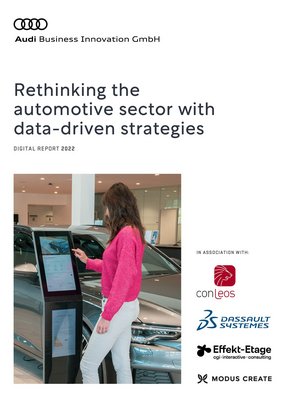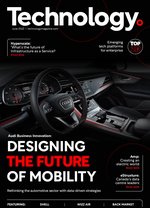Rethinking the automotive sector with data-driven strategies
Looking to rethink the automotive core business, Audi Business Innovation GmbH (ABI) provides forward-thinking digital product development and innovation offering IT expertise for user-centric solutions.
Launched in 2013 by Audi, ABI is a wholly-owned subsidiary acting as a speedboat for digital product and business development at Audi. At the heart of this innovation is Thomas Zuchtriegel, Head of AVP and Advisor at ABI.
“With our entrepreneurial thinking, our product and IT expertise for customer-driven solutions, and our mindset, we co-create the digital transformation,” says Zuchtriegel.
“Our overall objective is to strengthen the sales and distribution processes of Audi AG by providing relevant digital solutions and reliable IT platforms. We provide the concept of digital services and business models, while orchestrating and running digital product development processes and also implementing digital services along the whole value chain, with a focus on the efficiency of marketing and sales processes,” he continues.
Through its innovative approach, ABI makes a significant contribution to the digitisation of the customer journey. Its technology enables the constant improvement of the Audi user experience through data-driven product developments with a measurable contribution to the customer experience performance.
“Our mindset and personal attitude enable us to challenge the results of our work constantly and to strive for continuous improvement of our business. It is within our DNA to generate added value through innovative ideas and new concepts,” comments Zuchtriegel.
Developing the AVP for an enhanced customer experience
The AVP is Audi’s tool that can visualise the configuration of a product and car based on computer-aided design (CAD) data in real time, as well as in 3D. At the same time, the AVP has the ability to process huge amounts of data based on product data systems in a highly automated way.
“We invented and developed the Automotive Visualisation Platform (AVP). We are developing the building blocks to build all Audi websites. ABI is also building and running relevant components in the area of CRM, performance marketing and eCommerce. With our specific skills and a clear method set for digital product development, we are shaping the implementation of the AUDI AG's digital service portfolio,” explains Zuchtriegel.
With this technology, ABI aims to combine the digital and analogue touchpoints for end customers and for the dealerships/sales into a seamless customer journey to create an outstanding experience.
Discussing the AVP platform, Zuchtriegel says: “The desire for new, additional content types is increasing daily. The AVP allows flexible adaptations and fast production in a highly-integrated, secure ecosystem.”
Using digital twin technology, the AVP can create 3D models of a specific product before it is manufactured, which can then be used in several ways: “Based on these 3D models, we create experiences and produce content across all marketing and sales channels for markets all around the world,” adds Zuchtriegel.
The AVP is the core component in the product visualisation ecosystem and, to extend its options to scale and innovate further, ABI looks to select the correct partner companies that are perfectly equipped to support the company.
“We are always looking for the right mindset in our partners: collaborative, agile, tech-driven, customer-centric, and always focused on the business value. With a mutual partnership or mutual empowerment, we have, in the end, more innovation and more scalability to serve more touchpoints to more customers and even more brands in our case. This way we generate a win-win scenario, and everybody benefits from it,” says Zuchtriegel.
CGI agencies like Effekt Etage for example support ABI with its product staging and portfolio of innovative technologies, as Zuchtriegel explains: “Effekt-Etage assures that all cars look nice from all angles. They create 3D environments and do a lot of content production for marketing assets at scale, and, beyond that, they do proprietary software development for specific use cases.”
Focusing on data for business success
For these digital twins, ABI has created a robust and comprehensive data strategy to ensure the digital models accurately create the 3D images of automotive products.
“‘Own the data, own the process, enable the experience’ is how we aim to manage and successfully harness our data for the AVP. We constantly improve user experiences through data-driven product developments with measurable contributions to the customer experience performance,” comments Zuchtriegel.
Not only is data imperative for the AVP, but it also helps drive the business forward. Using data insight as a quantitative approach in addition to qualitative feedback, ABI has developed new business models and, as Zuchtriegel explains, “the data from the feedback has been the foundation for the AVP and its development. We can use it to build upon short iterative cycles and improve the products”.
“AVP started with Audi City, the world’s first digital showroom. It then started small with multiple small pilots. Today it’s a strongly growing business with multiple business models based on 3D data, data insights and customer feedback,” he continues.
This data-driven approach assures a seamless digital customer experience across multiple channels and drives millions of interactions per year, driving Audi forward. On top of this, the creation of digital ‒ or virtual twins ‒ generates huge time savings and empowers new business applications, notes Zuchtriegel.
He adds: “The digital twin, or the virtual twin, is the core of all we do. If you want to purchase a car, or if you want to even experience some piece of the brand, you want to show the product. The product portfolios are increasing almost every year, which means there are more and more options and variations to personalise the needs of the customer. You need to visualise it digitally ‒ you can't take pictures because it's too time-consuming, too expensive.”
“You can't do it in a short period of time for the millions of assets and interactions we enable on a daily basis. And, therefore, the virtual twin is the core. It's also important to develop the virtual twin further, fitting to the changing customer requirements, as well as new touchpoints, new formats and new use cases. We have a tremendous cost reduction in insourcing the core components and using them in a synergetic way across different touchpoints.
“Talking about retail, we brought down the time to market from around six weeks to just a couple of hours. All the interactive, real-time experiences and increased user engagement have a real impact on the revenue. In the end, it's all about the personalisation of products and services in the customer experience. The biggest benefit, from my point of view, is that we assure a seamless digital customer journey across all the different channels,” comments Zuchtriegel.
To gain additional support for its digital twin technology, ABI enlisted Dassault Systèmes 3DEXCITE, which acts as a downstream partner for digital services.
Zuchtriegel comments: “We have worked with Dassault Systèmes’ software, CATIA, and Deltagen for more than 10 years to create virtual twins. They drive standards, which help us ‒ and even others ‒ to automate. Dassault Systèmes focuses on simplification and convenience to enable ecosystem development.”
ABI also looks to conLeos, an experienced partner that provides ABI with configurator systems. With more than 20 years of experience working with Audi and the Volkswagen group, conLeos are experts in smart caching algorithms. With this, Zuchtriegel explains how it supports the AVP: “The user gets the images on the configurator, or any experience, as fast as possible. This saves a lot of render time. We have mutual enablement in the area of software development and services, and we all have an intrinsic drive to deliver best-in-class products, which can be said the same for all of our partnerships.”
He adds: “There are long-lasting partnerships as the world is small in the visualisation sector, especially in the automotive one. You run into the same experts over and over again as they gain so much expertise.”
Looking to the future, Zuchtriegel believes that the automotive industry will continue to focus on the customer, and personalisation will be the driving force behind improving the user experience across all channels: experiential, digital, and virtual.
“With the Automotive Visualisation Platform, we continue assuring multi-brand readiness. In a couple of months, Volkswagen passenger cars, Volkswagen commercial vehicles, and Cupra will go live with the AVP in different channels, from retail to online in multiple markets. We are also working with new customers with new data, so there are additional requirements where we need to figure out how can we adapt what we already have ‒ how can we leverage the data and how can we create a win-win scenario for everybody who's working on and using AVP?”






